Sustainable trade
Addressing the risk of carbon leakage: Assessing the EU’s carbon border adjustment mechanism

Published 21 November 2022
Even if theoretically sound, the EU's carbon border adjustment mechanism (CBAM) proposal will likely face significant implementation obstacles. Political resistance from trading partners is already rising, and there are potential legal challenges at the WTO. Correspondingly, it is important for ASEAN and other EU trading partners to deepen their understanding of the CBAM proposal and to generate improvements and possible alternatives.
As countries adopt climate action policies and emissions reduction targets, there is growing concern about “carbon leakage”, where efforts to reduce greenhouse gas emissions in one country can inadvertently result in an increase in high-carbon production or consumption elsewhere. While there is no firm evidence that carbon leakage is currently occurring, policymakers are already considering ways to prevent carbon leakage or limit its impact.
The first mover on this issue is the European Union (EU), which is set to introduce a Carbon Border Adjustment Mechanism (CBAM) from next year, affecting imports of high-carbon goods into the EU. Some of the EU’s trading partners have already expressed concern about the administrative burden needed to comply with the CBAM and have questioned whether the policy is compatible with World Trade Organization (WTO) rules.
This working paper from the Singapore Institute of International Affairs (SIIA) analyses the EU’s forthcoming CBAM policy. The paper first explains the problem of carbon leakage, before looking at the impact of the EU’s CBAM with a focus on its implications for international trade as well as ASEAN and Asian economies. The paper also discusses other approaches to addressing carbon leakage that have been proposed by experts.
The Hinrich Foundation sponsored this SIIA paper.
Download Addressing the Risk of Carbon Leakage: Assessing the EU’s Carbon Border Adjustment Mechanism by Singapore Institute of International Affairs (SIIA):
© The Hinrich Foundation. See our website Terms and conditions for our copyright and reprint policy. All statements of fact and the views, conclusions and recommendations expressed in this publication are the sole responsibility of the author(s).
Related Articles

Making the most of the ‘C’ in APEC – for cooperation to tackle climate change
09 November 2021

Counting carbon: The implications of border carbon adjustments on developing countries
14 December 2021

Making the most of the ‘C’ in APEC – for cooperation to tackle climate change
09 November 2021

Counting carbon: The implications of border carbon adjustments on developing countries
14 December 2021

Making the most of the ‘C’ in APEC – for cooperation to tackle climate change
09 November 2021



